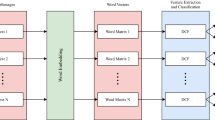Abstract
Rapidly, advancing technology is a double-edged sword as both friend and foe get access to said technology. Spam has become more prevalent than ever with malicious actors using advanced technology to create extremely convincing spam that can lead to major cybersecurity breaches. It has become imperative that we use advanced techniques to combat the proliferation of spam. The objective of our work is to present a systematic overview of the effectiveness of different machine learning and deep learning models integrated with natural language processing concepts. The paper analyzes the different approaches that can be used to identify spam accurately and identifies the most efficient techniques to achieve it. The discussion utilizes a wide range of datasets from email and SMSs to tweets and implements different algorithms like Naïve Bayes, XGBoost, random forest, and convolutional neural networks among others to perform a comprehensive analysis of the best suited methods to achieve high efficiency in identifying spam. It was observed that deep learning models displayed the highest accuracies for spam detection in SMS and emails, while random forest was the most accurate for detecting spam in tweets.
Access this chapter
Tax calculation will be finalised at checkout
Purchases are for personal use only
Similar content being viewed by others
References
Trivedi SK (2016) A study of machine learning classifiers for spam detection. In: 2016 4th international symposium on computational and business intelligence (ISCBI), pp 176–180. https://doi.org/10.1109/ISCBI.2016.7743279
Kumar N, Sonowal S, Nishant (2020). Email spam detection using machine learning algorithms. 2020 second international conference on inventive research in computing applications (ICIRCA). https://doi.org/10.1109/icirca48905.2020.9183098
Ameen AK, Kaya B (2018) Spam detection in online social networks by deep learning. In: 2018 international conference on artificial intelligence and data processing (IDAP), Malatya, Turkey, pp 1–4
Gupta M, Bakliwal A, Agarwal S, Mehndiratta P (2018) A comparative study of spam SMS detection using machine learning classifiers. In: 2018 eleventh international conference on contemporary computing (IC3). https://doi.org/10.1109/ic3.2018.8530469
McCord M, Chuah M (2011) Spam detection on twitter using traditional classifiers. In: Autonomic and trusted computing, pp 175–186. https://doi.org/10.1007/978-3-642-23496-5_13
Crawford M, Khoshgoftaar TM, Prusa JD et al (2015) Survey of review spam detection using machine learning techniques. J Big Data 2:23
Choudhary N, Jain A (2017) Towards filtering of SMS spam messages using machine learning based technique. In: Communications in computer and information science advanced informatics for computing research. Springer, Singapore
Wang AH (2010) Detecting spam bots in online social networking sites: a machine learning approach. In: Foresti S, Jajodia S (eds) Data and applications security and privacy XXIV. DBSec 2010. Lecture notes in computer science, vol 6166. Springer, Berlin. https://doi.org/10.1007/978-3-642-13739-6_25
Shirani-Mehr H (2013) SMS spam detection using machine learning approach. Unpublished http://cs229.stanford.edu/proj2013/ShiraniMehr-SMSSpamDetectionUsingMachineLearningApproach.pdf
Wu T, Liu S, Zhang J, Xiang Y (2017) Twitter spam detection based on deep learning. In: Proceedings of the Australasian computer science week multiconference (ACSW ‘17). Association for computing machinery, New York, NY, USA, Article 3, pp 1–8. https://doi.org/10.1145/3014812.3014815
Mikolov T, Chen K, Corrado G, Dean J (2013) Efficient estimation of word representations in vector space. Preprint at arXiv:1301.3781
Bhalerao V, Deshmukh RA (2020) Performance comparison for spam detection in social media using deep learning algorithms. Inter J Future Generation Commun Netw 13(3):3104–3311. https://doi.org/10.17762/TURCOMAT.V12I1S.1609
Hua J, Huaxiang Z (2015) Analysis on the content features and their correlation of web pages for spam detection. China Commun 12(3):84–94
Jain G, Sharma M, Agarwal B (2019) Spam detection in social media using convolutional and long short-term memory neural network. Ann Math Artif Intell 85(1):21–44
Shekhawat SS, Sharma H, Kumar S (2021) Memetic spider monkey optimization for spam review detection problem. Big Data. https://doi.org/10.1089/big.2020.0188
Shekhawat SS, Sharma H, Kumar S, Nayyar A, Qureshi B (2021) bSSA: Binary Salp Swarm Algorithm with hybrid data transformation for feature selection. IEEE Access 9:14867–14882
Chen T, Carlos G (2016) Xgboost: a scalable tree boosting system. In: Proceedings of the 22nd ACM SIGKDD international conference on knowledge discovery and data mining
Tolles J, Meurer WJ (2016) Logistic Regression Relating Patient Characteristics to Outcomes. JAMA 316(5):533–534. https://doi.org/10.1001/jama.2016.7653.ISSN0098-7484.OCLC6823603312.PMID27483067
Hastie T, Tibshirani R, Friedman J, Jerome H (2001) The elements of statistical learning: data mining, inference, and prediction: with 200 full-color illustrations. Springer, New York. ISBN 0-387-95284-5. OCLC 46809224
Cortes C, Vapnik VN. (1995). Support-vector networks (PDF). Machine Learning 20(3):273–297. CiteSeerX 10.1.1.15.9362. https://doi.org/10.1007/BF00994018. S2CID 206787478.
Wu X, Kumar V, Ross Quinlan J, Ghosh J, Yang Q, Motoda H, McLachlan GJ, Ng A, Liu B, Yu PS, Zhou Z-H (2008) Top 10 algorithms in data mining. Knowl Inf Syst 14(1):1–37. https://doi.org/10.1007/s10115-007-0114-2. hdl:10983/15329. ISSN 0219–3116. S2CID 2367747
Ho TK (1995) Random decision forests (PDF). In: Proceedings of the 3rd international conference on document analysis and recognition, Montreal, QC, 14–16 August 1995. pp 278–282. Archived from the original (PDF) on 17 April 2016. Retrieved 5 June 2016
Rajaraman A, Ullman JD (2011) Data mining (PDF). In: Mining of massive datasets. pp 1–17. https://doi.org/10.1017/CBO9781139058452.002
Sepp H, Jürgen S (1997) Long short-term memory. Neural Computation 9(8):1735–1780. https://doi.org/10.1162/neco.1997.9.8.1735. PMID 9377276. S2CID 1915014
Author information
Authors and Affiliations
Corresponding author
Editor information
Editors and Affiliations
Rights and permissions
Copyright information
© 2022 The Author(s), under exclusive license to Springer Nature Singapore Pte Ltd.
About this paper
Cite this paper
Anil, A., Sajwan, A., Ramchandar, L., Subhashini, N. (2022). Advanced Spam Detection Using NLP and Deep Learning. In: Saraswat, M., Sharma, H., Balachandran, K., Kim, J.H., Bansal, J.C. (eds) Congress on Intelligent Systems. Lecture Notes on Data Engineering and Communications Technologies, vol 114. Springer, Singapore. https://doi.org/10.1007/978-981-16-9416-5_23
Download citation
DOI: https://doi.org/10.1007/978-981-16-9416-5_23
Published:
Publisher Name: Springer, Singapore
Print ISBN: 978-981-16-9415-8
Online ISBN: 978-981-16-9416-5
eBook Packages: Intelligent Technologies and RoboticsIntelligent Technologies and Robotics (R0)




